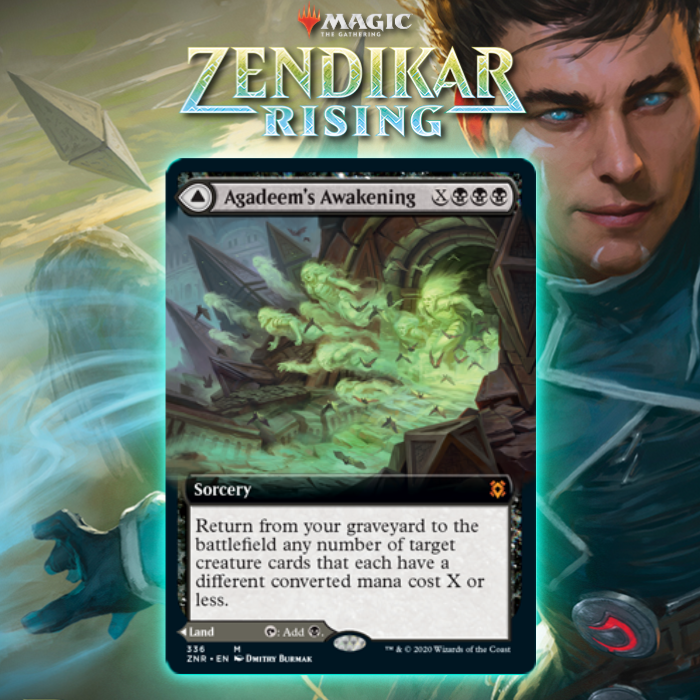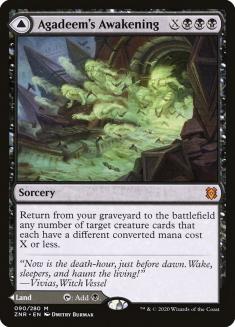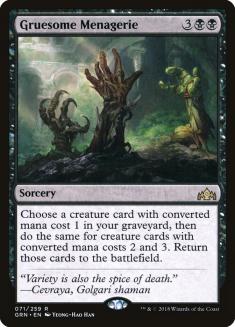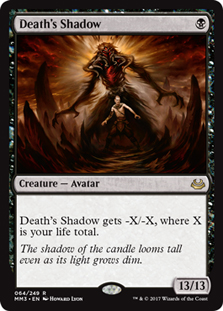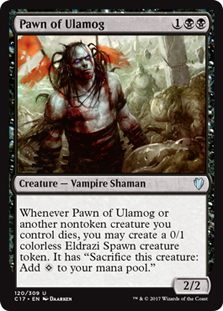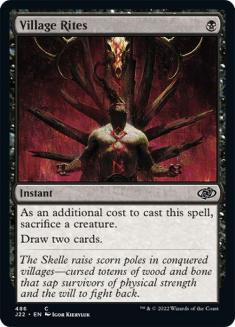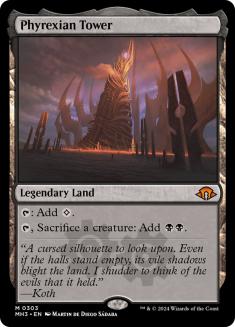When they were first previewed, I thought there’d be maybe fifteen modal double-faced cards (DFCs) that were spells on the front and lands on the back in Zendikar Rising, but it turns out there are a lot more. That means we won’t feel like there’s some certain card you play because it lets you get value out of a flexible land slot in your deck.
Instead, we can get cards that can play this role while making sense in whatever kind of deck we’re playing. More competition means more of these cards will be played in total, but each individual card is less likely to be played. That means the floor is higher. “This is a land that can technically be cast as a spell” isn’t anywhere near good enough.
Agadeem’s Awakening blows away most of the competition.
To start with, the ability to pay three life to enter the battlefield untapped is a massive advantage over not having that ability. So what do cards have to give up to get that line of text? Commonality. The spells aren’t weaker; the cards just take a mythic rare slot.
Honestly, I find this a little disappointing because it makes it so hard for the other modal DFCs to compete for use in Constructed decks. We have a set full of these things, but realistically, one in each color is so much better than the others just because the land side is strictly better. Being mythic rares, obviously the spell sides also tend to be among the best if not clearly the best spells available. They tend to be expensive, but given that you want split cards where the two different modes are as distinct as possible, “land for when you don’t have mana, big spell for when you do” is a pretty strong baseline. I do think a few of the non-mythic modal DFCs will see play, but the bar is high.
As for Agadeem’s Awakening the spell, I always loved Gruesome Menagerie but it always felt like it was just not quite good enough. For an extra B in the casting cost, this is more flexible as a spell — Gruesome Menagerie is Agadeem’s Awakening with X=3, but this spell can be cast for other numbers, and also, of course, is much more flexible in that it can be played as a land.
This is the kind of spell you can build a deck around that gives you a great late-game finisher, and you can just effortlessly play four of them without worrying about clogging your hand because the extras are just land. I expect this to be good in Standard, Pioneer, Historic, and Modern. Let’s look at how.
Modern
The most obvious pairing in Modern is Agadeem’s Awakening with Death’s Shadow to really get the most out of that “pay 3 life” ability. A big Death’s Shadow can easily be worth four mana, so you can get the most out of this spell for the least mana by playing them with each other. Among existing Death’s Shadow decks, you’d most want to play it in Jund Death’s Shadow so that you can return Tarmogoyf with your Death’s Shadow if you cast this for X=2, but with the addition of Scourge of the Skyclaves as an additional Death’s Shadow, we might be able to have a strong two-mana creature to return in any color combination.
Most Death’s Shadow decks have been three colors with very low land counts, and the lands they play do really heavy lifting hitting their colored mana requirements because the spells in the deck use very little colorless mana. As a result, it’s actually remarkably hard to just replace a land with Agadeem’s Awakening, so I don’t think Death’s Shadow can actually play a lot of copies of this, but it’s an interesting tool.
Creatures (14)
Lands (18)
Spells (28)

This is a low-risk, conventional use of Agadeem’s Awakening, but it could also be the missing piece for other new archetypes. Maybe even Vampires?
Creatures (24)
- 4 Bloodghast
- 4 Viscera Seer
- 1 Captivating Vampire
- 4 Blood Artist
- 3 Champion of Dusk
- 4 Cordial Vampire
- 4 Knight of the Ebon Legion
Planeswalkers (4)
Lands (20)
Spells (12)

I’m not sure about Sorin and Champion of Dusk. Another way to build it is to go a little more combo-based and replace those with Bloodthrone Vampire and Pawn of Ulamog. There’s some exciting combo potential there with Blood Artist and Cordial Vampire, especially since the Eldrazi Spawns can pay for Agadeem’s Awakening, but I felt like I should stick with cards that have at least proven themselves in Standard, though that could easily be a big mistake.
Blood Artist feels a little weird in this version that seems designed to play a more normal aggressive game, but I feel like Cordial Vampire makes the base stats on your creatures a lot less important, so picking up Blood Artist’s ability seems a lot better than splashing for Legion Lieutenant or something.
You could build a similar Zombie deck, but we’ll be seeing plenty of Stitcher’s Supplier in other formats, so let’s move on.
Pioneer
In Pioneer I’m inclined to play more colors and take advantage of Stitcher’s Supplier and Satyr Wayfinder with Uro, Titan of Nature’s Wrath as a core set of one-, two-, and three-mana creatures. That core is really flexible in Pioneer, but here’s a start:
Creatures (19)
- 1 Scavenging Ooze
- 2 Deathrite Shaman
- 1 Courser of Kruphix
- 4 Satyr Wayfinder
- 1 Jace, Vryn's Prodigy
- 1 Tireless Tracker
- 4 Stitcher's Supplier
- 4 Uro, Titan of Nature's Wrath
- 1 Lurrus of the Dream-Den
Planeswalkers (1)
Lands (23)
Spells (17)

Pioneer Sultai Delirium decks usually don’t play Stitcher’s Supplier, but Uro allows you to take advantage of the milling that it offers and it’s a nice way to power up your Agadeem’s Awakenings, especially since it allows you to also play Deathrite Shaman.
I decided to try something weird here and I’m playing four Village Rites to pair with Stitcher’s Supplier; Satyr Wayfinder; and Uro, Titan of Nature’s Wrath, which help make sure that I can get the full mill six out of my Stitcher’s Suppliers and also make sure my creatures go to the graveyard so that I can return them with Agadeem’s Awakening. This also just adds a lot of card drawing to the deck in a way that I haven’t really seen played before that looks interesting to me.
Agadeem’s Awakening is also an easy upgrade to any existing Mono-Black Aggro deck in Pioneer, but I’m more excited about that archetype in Historic.
Historic
Historic offers us the addition of Phyrexian Tower, a card not even Modern can match. It’s probably the single best card to pair with Agadeem’s Awakening, since it allows us to make sure our value creatures end up in our graveyard while offering the extra mana to cast Agadeem’s Awakening for an extra creature.
Creatures (28)
- 4 Blood Artist
- 4 Stitcher's Supplier
- 3 Midnight Reaper
- 4 Priest of Forgotten Gods
- 3 Cauldron Familiar
- 2 Stonecoil Serpent
- 3 Woe Strider
- 2 Lurrus of the Dream-Den
- 3 Archfiend's Vessel
Lands (20)
Spells (12)

Stonecoil Serpent is pretty cute with Agadeem’s Awakening in a deck with Blood Artist and Midnight Reaper, since it just adds a death trigger to any casting of Agadeem’s Awakening, and it’s not that bad of a card to just cast normally. I’m not sure if cute Blood Artist stuff is better than Mono-Black God-Pharaoh’s Gift, but I think this deck takes better advantage of having all of its various engine pieces on the battlefield at the same time, so it’s at least more improved by Agadeem’s Awakening.
I’m also not sure if it’s correct for this deck not to splash Claim the Firstborn, but I think the mana gets quite a bit worse if you do it.
Standard
I haven’t fully wrapped my head around Zendikar Rising Standard yet, but a few things to consider:
Edgewall Innkeeper and Gilded Goose are solid one-mana creatures to return and Golgari Adventures was good in a previous small Standard format, so it’s interesting to consider, but that deck relied heavily on Once Upon a Time.
Agadeem’s Awakening is at its best in synergy decks that benefit from having several different creatures on the battlefield at the same time. This means it could be good in any tribal deck in the new Standard, especially if there’s some kind of Cleric deck that uses Cleric of Life’s Bond; Orah, Skyclave Hierophant; and Taborax, Hope’s Demise. It would also be a great way to assemble a full party to take advantage of party payoffs.
Okay, let’s take a look at what we have for Clerics at the moment:
Creatures (31)
- 2 Heliod, Sun-Crowned
- 2 Lurrus of the Dream-Den
- 2 Vito, Thorn of the Dusk Rose
- 4 Archfiend's Vessel
- 4 Speaker of the Heavens
- 3 Orah, Skyclave Hierophant
- 4 Cleric of Life's Bond
- 2 Taborax, Hope's Demise
- 4 Skyclave Cleric
- 4 Nullpriest of Oblivion
Lands (17)
Spells (12)

I have no idea what to make of this. It has twelve lands that can be spells, and I think it’s possible that Temple of Silence might not be worth playing over more modal DFCs. The creatures seem a little underwhelming, but it’s hard to evaluate how much greater they are than the sum of their parts when combined. Also, it’s a bunch of random creatures that generally gain life to prolong the game, and then a bunch of huge spells that are also lands, but I’m not really sure if that means it wins long games against other decks that also have these late games.
If it’s possible to pull off a deck that tries to assemble a full party, it feels like Agadeem’s Awakening should be the best way to get them all on the battlefield at the same time through your opponent’s removal. The trick is, at the moment I haven’t found a good way to get a good mix of all the types of creatures in two or even three colors. I assume we’d have to lean on Tajuru Paragon and Base Camp, but if I were to play Abzan, for example, I don’t really like any other Wizards available. Maybe I just need to play Veteran Adventurer?
Creatures (24)
- 1 Chevill, Bane of Monsters
- 4 Seasoned Hallowblade
- 4 Acquisitions Expert
- 1 Tazri, Beacon of Unity
- 4 Tajuru Paragon
- 4 Archpriest of Iona
- 4 Veteran Adventurer
- 2 Squad Commander
Lands (20)
Spells (16)

Conceptually, Coveted Prize feels like the biggest payoff for the party mechanic, but in practice I think it’s pretty bad in a creature deck like this if you don’t have a full party, and then I think the default is just finding Squad Commander. But at that point, I think I’d rather draw a Squad Commander, and it’s hard to get much of a toolbox in this kind of deck. Further, I think modal DFCs make it less important to have this kind of optionality.
These have largely been decks built to maximize Agadeem’s Awakening, but Agadeem’s Awakening is also easy to add to any deck that can afford to play basic Swamps and has a reasonable curve of cheap creatures. In those decks, I expect it will only be worth playing a few copies, but I think this card will have a big impact.

